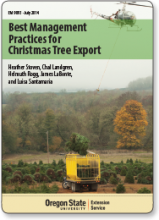Barypeithes pellucidus, Sciopithes obscurus, Nemocestes spp., and Otiorhynchus spp.
Pest identification
- Adults are 2 to 11 mm (1∕16 to 1∕2") in length.
- Typically brown or black in color
- Larvae are C-shaped, legless grubs with a brown head and white body.
Biology and life cycle
- Root weevils can cause significant crop loss as well as cause load rejection for Christmas tree exporters.
- Late-stage weevil larvae are present in late spring and summer.
- Larvae feeding on tree roots cause the most damage.
- Pupae occur from late May into early June.
- Adults are present year round.
- Adults typically feed on needles at night.
- Adults can girdle seedlings and small trees.
- Adults lay eggs in soil 4 to 6 weeks after their emergence.
- Individuals of most species are all egg-laying females.
- There is one generation per year.
- Barypeithes pellucidus and Otiorhynchus spp. were accidentally introduced from Europe. Nemocestes spp. and Sciopithes obscurus are native.
Noble fir most susceptible, followed by Douglas-fir, grand fir, Nordmann fir, and Turkish fir
Growing years
- Look for adults on cloudy days and at night on branches and trunks; use beating boards and sheets. (See Overview of Trapping and Monitoring Options.)
- Look for notching of needles and girdling of small trees and branches (evidence of adult feeding).
- Place pitfall traps in the field for monitoring. (See Overview of Trapping and Monitoring Options.)
- Check for adults during the day under pieces of plywood placed on the ground overnight (similar to slug monitoring).
- Dig with a shovel around roots to monitor for larvae.
- Note: Evidence of digging by insect-eating mammals can be an indication of the presence of larvae.
At harvest
- Look for adults on trees that show evidence of notching on needles.
- Look for adults on cloudy days or at night on branches and trunks.
- Use pitfall traps or check under pieces of plywood placed on the ground.
Threshold
- Some trading partners, such as Mexico, Japan, and Hawaii, have zero tolerance for some or all root weevil species.
Growing years
- Apply pesticides as adults become active and before egg laying occurs. (Visit the PNW Insect Management Handbook.)
- Apply labeled insecticide in the evening during peak adult activity in May to June.
- Disrupt habitat (for example, by disking or tilling in the summer and fall) to reduce populations.
- Reduce shelter and additional hosts by controlling weeds around loading areas.
- Preserve populations of rove and other naturally-present ground beetles, as they can be important biological control agents.
- Note: Nematodes and fungi have been used as biocontrol agents in Christmas trees.
At harvest
- Shake trees according to compliance agreements for destination countries. (See Best Management Practices at Harvest.)
- Keep trees off the ground at harvest, especially after shaking. Trees left overnight on the ground are very vulnerable to root weevil infestation.
- Do not place trees near shaking debris; remove debris frequently.
Life cycle

- Look for eggs: mid-July through mid-August
- Look for larvae: mid-August through June
- Look for pupae: May through June
- Look for adults: all year
Management

- Notched needles present: June through mid-November
- Monitor for larvae by digging: April through May
- Monitor for adults with traps/boards or by scouting at night: June through September
- Apply biocontrol: April through May
- Apply foliar insecticide sprays: May through June
- Disrupt habitat by disking or tilling: September through the beginning of October


